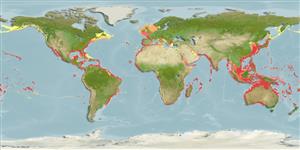>
Carangiformes (Jacks) >
Echeneidae (Remoras)
Etymology: Remora: Latin, remora = delay, hindrance (1567) (Ref. 45335); remora: remora meaning delay or hindrance; these fish were once thought to delay a ship's progress when they attached to the hull (Ref. 4389).
More on author: Linnaeus.
Environment: milieu / Klimaatzone / Diepte / distribution range
Ecologie
marien rifbewoner; diepte 0 - 200 m (Ref. 86942). Subtropical; 60°N - 36°S, 180°W - 180°E
Cosmopolitan in warm waters.
Grootte / Gewicht / Leeftijd
Maturiteit: Lm ? range ? - ? cm
Max length : 86.4 cm TL mannelijk / geslacht onbekend; (Ref. 26340); common length : 40.0 cm TL mannelijk / geslacht onbekend; (Ref. 26999); max. gepubliceerd gewicht: 1.1 kg (Ref. 40637)
Dorsale stekels (totaal) : 0; Dorsale zachte stralen (totaal) : 22 - 26; Anale stekels: 0; Anale zachte stralen: 22 - 24. Dark brownish grey in color (Ref. 4389). During the course of development, fin is transformed into a suction disc (Ref. 35388). Deeper-bodied than Echeneis naucrates (Ref. 37816).
Body shape (shape guide): elongated.
Usually associated with sharks but also attaches itself to other large fishes, sea turtles and even ships (Ref. 2850, 58302); found in gill chambers, fins and body surface (Ref. 5951). Sometimes free-swimming (Ref. 2850). Younger individual is more active as parasite pickers (Ref. 26938). Feeds on parasitic copepods (Ref. 35388).
Levenscyclus en paargedrag
Maturiteit | Voortplanting | Paaien | Eieren | Fecunditeit | Larven
Lachner, E.A. and A. Post, 1990. Echeneidae. p. 725-728. In J. C. Quéro, J. C. Hureau, C. Karrer, A. Post and L. Saldanha (eds.) Check-list of the fishes of the eastern tropical Atlantic (CLOFETA). JNICT, Lisbon; SEI, Paris; and UNESCO, Paris. Vol. 2. (Ref. 10791)
Status op de Rode Lijst van het IUCN (Ref. 130435: Version 2025-1)
Gevaar voor de mens
Harmless
Gebruik door de mens
Visserij: commercieel; sportvis: ja
Tools
Speciale rapporten
Download XML
Internetbronnen
Estimates based on models
Preferred temperature (Ref.
123201): 11.7 - 28.2, mean 24.8 °C (based on 2107 cells).
Fylogenetische diversiteitsindex (Ref.
82804): PD
50 = 0.5352 [Uniqueness, from 0.5 = low to 2.0 = high].
Bayesian length-weight: a=0.00257 (0.00110 - 0.00600), b=3.17 (2.96 - 3.38), in cm total length, based on LWR estimates for this (Sub)family-body shape (Ref.
93245).
Trofisch niveau (Ref.
69278): 3.5 ±0.4 se; based on diet studies.
Weerstandsvermogen (Ref.
120179): Gemiddeld, minimale populatieverdubbelingstijd 1,4-4,4 jaar (Assuming Fec < 10,000).
Fishing Vulnerability (Ref.
59153): Moderate to high vulnerability (55 of 100).
🛈
Nutrients (Ref.
124155): Calcium = 25.5 [12.2, 40.8] mg/100g; Iron = 0.629 [0.346, 1.051] mg/100g; Protein = 19.3 [18.3, 20.3] %; Omega3 = 0.129 [0.069, 0.242] g/100g; Selenium = 33.4 [15.8, 66.4] μg/100g; VitaminA = 30.4 [10.1, 96.3] μg/100g; Zinc = 0.657 [0.432, 0.989] mg/100g (wet weight);
